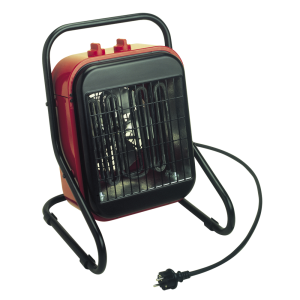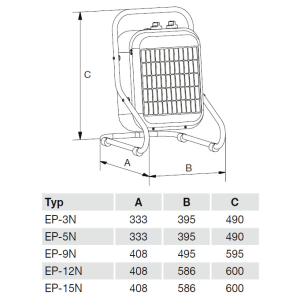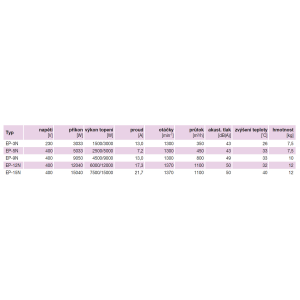Cabinet
It is made of sheet steel, coated with a burning varnish. A stand made of steel pipe is screwed to the cabinet, which allows two basic positions for the fan to be placed and carried at the same time.
Running wheel
is axial, moulded from Al sheet. The blades are performance optimized.
Motor
is asynchronous with short armature and shielded pole. It is designed for continuous operation. The motor has grease-filled plain bearings for life. The motor has overload protection. Protection rating IP24.
Regulation
is carried out by 2 controls directly on the device. One sets the type of operation (see below), the other controls the switching thermostat. Using the switch on the rear panel, it is possible to select whether the thermostat will run the fan and heat or only heat when the fan is permanently on.
Electrical connection
The connection is by a cable that is routed out of the cabinet through a grommet and terminated with a 5-prong 400V fork.
The EP-3N model is single phase and the supply has a single phase fork.Operation
The electrically heated fan is designed to operate on a horizontal pad or floor. When doing so, care must be taken to ensure that the inlet or discharge side is not covered by the heating rod housing. In this case, the air flow through the cabinet could be restricted and the temperature could rise, with a consequent risk of fire. If the air temperature rises, the unit will be switched off by the safety thermostat, whose reset button is located on the top of the cabinet.
Operating modes:
- fan only
- fan and half heating power
- fan and full heating power
Noise
emitted by the fan measured at a distance of 1.5 m in the free sound field with the fan placed on the floor is given in the table.
Variants
- EP-3N basic design 3 kW/230 V
- EP-5N basic design 5 kW/400 V
- EP-9N basic design 9 kW/400 V
- EP-12N basic design 12 kW/400 V
- EP-15N basic design 15 kW/400 V
Instructions
Electrically heated fans are suitable for drying wet areas and for heating in industry and construction. The places of use are mainly production halls, warehouse halls, common rooms, churches, exhibition halls, buildings and construction site facilities, garages and workshops.
Highlights
A safe distance from combustible structures, as specified in the user's operating rules, must be maintained.






 Share on Facebook
Share on Facebook Tweet
Tweet Send email
Send email